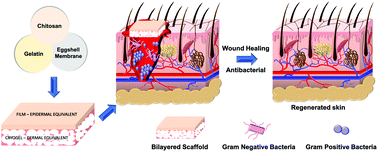A bilayered skin substitute developed using an eggshell membrane crosslinked gelatin–chitosan cryogel†
Abstract
Commercially available allografts and xenografts pose problems such as high cost, risk of infection transmission and immune rejection of grafts. Thus, bioengineered skin substitutes fabricated from natural biomaterials or synthetic polymers are currently the focus of skin tissue engineering. In this study, eggshell membrane (ESM) powder was used to crosslink a gelatin–chitosan cryogel thereby replacing glutaraldehyde, a known cytotoxic chemical crosslinker. The resultant ESM-crosslinked macroporous cryogel with a pore size ranging between 10 and 350 μm has improved flexibility, biodegradability and biocompatibility compared to a glutaraldehyde-crosslinked cryogel. For healing of large and deep wounds, bilayered scaffolds which exhibit key aspects of skin physiology are being explored. Hence, we fabricated a bilayered substitute by coupling the ESM-crosslinked cryogel (dermal equivalent) to a non-porous, physically-crosslinked gelatin–chitosan film (epidermal equivalent). The epidermal layer provides the requisite barrier properties while the dermal layer facilitates cell attachment and migration for optimal wound healing. Further, chitosan confers antibacterial properties to the cryogel with almost 50% reduction in bacterial viability. Animal studies confirm that the developed bilayered skin substitute is non-allergic, aids wound healing by improving re-epithelialization within 14 days and supports the formation of skin appendages. This system presents a new and alternative treatment option for burn and chronic wounds.



 Please wait while we load your content...
Please wait while we load your content...